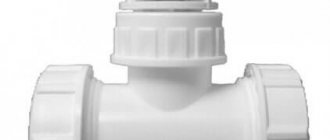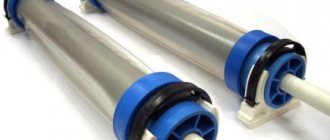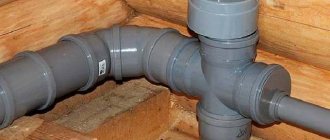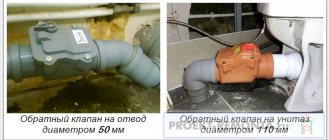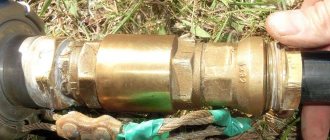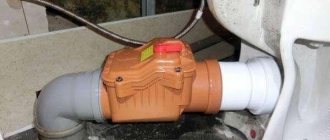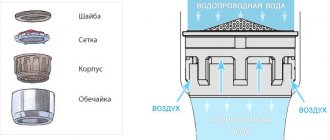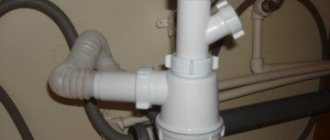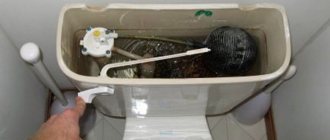In private and sometimes in communal residential buildings, when installing sewer lines with your own hands, you have to independently take measures to combat unpleasant odors from the pipes. One of the effective solutions to get rid of odors, which is widely used by plumbers, is to use a sewer aerator.
The device is sold in the retail chain in various versions; for its proper installation, it is useful to know the principle of its operation, the range offered, and installation diagrams. If you provide for the placement of an aerator at the design stage of a house's sewer system, you can significantly change the project, make it cheaper, and make the design of the premises more aesthetically pleasing.
Aerators in the sewer system
What is a sewer aerator
Water seals provide isolation of the internal cavity of pipes from the atmosphere of residential premises. These are plugs of water that are constantly in the bend of the siphons of all plumbing fixtures. If the pressure in the riser sharply increases or decreases, the water seal may be torn off and gases can freely penetrate into the apartment. By installing an aerator on a sewer pipe, owners of apartments with an unventilated riser have the opportunity to equalize the volume of air in the pipelines and maintain water seals. The simplest aerator is a small device consisting of a polypropylene (or PVC) body with a vacuum valve. There are also metal devices that have increased strength. More complex designs are capable of not only passing air inside the pipelines, but also removing excess pressure outside. The device is efficient and operates automatically. It does not require maintenance and does not require human intervention. If necessary, an aeration valve for sewage 110 or 50 mm can be installed independently.
Rules for installing an air valve for sewerage
There are a number of rules that must be followed during installation:
- If the sewer ventilation valve is mounted in the attic (on a riser), the temperature in the room must always be positive.
- If the ventilation valve is installed in a room with a floor grating, it must be at least 35 cm above the floor level.
- The valve must remain accessible for inspection and possible repairs. This is especially important if it is installed not in addition to, but instead of a fan pipe.
- The valve installed on the riser must be located at least 30 cm higher than the topmost pipe inlet from the plumbing fixture (i.e., there should be no other inlets from the valve for the next 30 cm down).
- There should be at least 20 cm from the valve to the nearest siphon.
Stages of work
If the installation of a sewer valve is carried out in an apartment building, it is necessary to inform the neighbors. After this, the riser is disconnected from the water supply, and you can proceed directly to installing the aerator:
- The section of pipe on which the product will be installed is dismantled.
- The valve, using a sealing ring, is inserted into a tee or outlet. In this case, the arrow on the body of the product must point in the direction of the flow of water through the pipe.
- Tee or elbow - mounted on a pipe.
As an option, you can install the aeration valve directly into the pipe, without using a tee or outlet.
Description of the “Finnish window”: advantages of the KIV-125 air vents
Russian-made supply valve: about the supply valves of the Era KP series
Related Posts
What is it for?
An aerator is a ventilation valve that is a substitute for a drain pipe. It represents the exit of the riser to the outside, through the attic floor and the roof of the house. The upper end of the sewer pipe is open, providing ventilation to the internal volume of the sewer network. In some multi-storey buildings, the riser does not have an exit to the outside, which creates conditions for sudden changes in pressure. During a volley discharge of water, a vacuum occurs in the upper sections of the riser, which can rupture the water seals of bathtubs, toilets and other devices. The sewer aerator plays the role of an inlet valve, which equalizes the pressure and maintains the tightness of the system. There are universal devices designed to correct pressure in both directions - both low and high. They are used to compensate for high pressure in the riser of a multi-story building. Even with a waste pipe, the volley discharge of wastewater creates excess pressure in the pipes. It finds its way into apartments through broken water seals. Such structures are installed in the attic or basement, since it is impractical to release aeration gases into the living space.
Manufacturer choice and price
To ensure that the sewage system works smoothly and does not cause unnecessary trouble, it is better to choose an air valve from trusted and well-known manufacturers. The most popular and best-selling aerators are produced by the following companies:
- Ostendorf – Germany;
- McAlpine - Scotland;
- Politek – Russia.
The table below shows the average prices for vacuum sewer valves from these manufacturers:
| Manufacturer | Size(mm) | Price, rub) |
| Ostendorf | 50 | 550 |
| 110 | 890 – 1 300 | |
| McAlpine | 50 | 480 |
| 110 | 1 100 | |
| Politek | 50 | 100 — 150 |
| 110 | 200 — 300 |
The prices indicated in the table are average for Moscow and the Moscow region. The exact cost can be found on the manufacturer's website.
When choosing a sewer aerator, carefully select the location for its installation and decide in advance on the required type and diameter of the device. If you install it yourself, follow the instructions and installation rules recommended by the valve manufacturer.
Video: Causes of sewer smell in the bathroom and kitchen + how to make a vacuum valve
Operating principle
The most common type is the sewer aerator 110, the operating principle of which is similar to the operation of a check valve. A sealed lid or elastic membrane is used as a locking part. Under the influence of its own weight, it closes the passage of air into the pipelines. The channel of the device is curved in such a way that the upper part of the valve interacts with the internal cavity of the pipelines. When a vacuum forms in the system, the lid (or membrane) is lifted, allowing outside air inside. As soon as the pressure is equalized, the lid closes again, preventing gas from entering the living space. There is a universal sewer aerator, the operating principle of which is based on two-way action. For these designs, the valve can operate for air inlet and outlet. As a rule, these aerators are not used in apartments, since they are capable of supplying biogas from the sewer into the room, which is unacceptable.
How to choose the right model
There are a number of parameters that must be taken into account when choosing an aerator:
- orientation of sewer system elements;
- type of device having a membrane, combined, lever, vacuum or cylindrical modification with a rotary or ball mechanism;
- nominal pressure indicators;
- device dimensions;
- features of the installation method;
- material used in manufacturing and its strength characteristics;
- the ability to manually adjust the device in the event of a structure failure or water seal failure.
According to experts, the best option is to purchase a valve system produced exclusively by well-known, trusted manufacturers. Only well-established companies produce equipment that operates smoothly and efficiently for a long time. The following brands are popular today:
- German company Ostendorf. The quality characteristics of the products produced by this manufacturer fully comply with all Russian standards. The production facilities of the German company are located in the Moscow region. All stages of the production of such an aerator for sewage are strictly controlled by specialists, and the average cost of the product is slightly less than one thousand rubles;
- Scottish company McAlpine. The products manufactured by this company are characterized by a fairly high cost, which is explained by durability and the use of only high-quality, proven raw materials in the production process. The average cost of such an aerator is about one and a half thousand rubles;
- Russian manufacturer Politek, whose modern products are quite affordable in the range of 250–300 rubles, and have also proven themselves to be reliable, aesthetically pleasing and guaranteed to last.
It should be remembered that any modification of a high-quality aerator must contain a special unit that effectively prevents the penetration of any rodents from the sewer system into the living space.
Types of aerators
There are several types of aerators. They can be grouped according to different criteria. At installation location:
- on the riser;
- directly onto the spout of appliances - toilets, bathtubs, etc.
Based on the operating principle:
- automatic. The simplest and cheapest gravity-type aerators. They are usually used in private systems or apartments. As a rule, they do not have high throughput;
- anti-vacuum. Act on air intake and exhaust. Capable of working simultaneously with several pipelines;
- combined. They are a combination of both types of devices.
By design:
- membrane The function of the valve is performed by an elastic membrane, which bends under pressure and allows air flow;
- cylindrical. These are the most durable and reliable aerators. They are made of metal and equipped with a threaded lid. They are typical check valves. A 50 or 110 mm cylindrical sewer aerator is considered the best device for installation in an apartment or private house;
- lever These devices are also made of metal. The valve is mounted on a lever, which rises under the pressure of gases from the system, and lowers under its own weight.
By type of connection to pipelines:
- threaded;
- flanged;
- coupling
The most common devices are designed for installation on a d110 mm pipe. They can be placed near the riser itself, being the first to respond to pressure changes and maintaining plumbing water seals.
You may also like: GOST water supply and sewerage internal networks!
Design
All aerators have approximately the same design; it consists of the following elements:
- frame;
- inlet pipe;
- mechanism that regulates the movement of the membrane.
The body is made of hard plastic, most often PVC is used. The housing must be sealed. If there is a crack on the body, the product must be rejected.
The opening mechanism can be represented by a rod or a membrane. When a vacuum occurs, the diaphragm rod or spring opens the passage, allowing air to enter the system and equalize the pressure.
Advice! Valves with a diaphragm mechanism are considered more reliable. The fact is that during operation, dust and dirt settle on the rod, which interfere with normal functioning.
When a vacuum occurs in the pipe, the mechanism opens and remains in this position until the pressure equalizes. After this, the valve will close the passage, the membrane will fall into place under the influence of gravity.
It is recommended to clean sewer aerators periodically. To facilitate maintenance of the model, the valve cover is usually made removable. It is connected to the body with a thread, and an elastic seal is additionally used.
Where and how to install
Depending on where and how the sewer aerator works, installation is carried out on vertical or horizontal pipelines. The main requirement is operation at a temperature not lower than 0°. Cold membranes lose elasticity, internal cavities become covered with frost and ice. Common installation locations are:
- areas where the horizontal line adjoins the riser in the apartment;
- pipe termination points in attics;
- basements.
All installation options require high-quality air exchange in the areas where the devices are used. Accumulations of biogas are explosive, so proper ventilation is important. In addition, additional requirements must be met:
- easy access to the device installation point;
- the aerator is mounted on a vertical outlet. For horizontal lines, you need a tee, the central part of which will be the connecting pipe;
- the installation height should be 10 cm higher than the level of the highest water seal in the system.
A 50 mm sewer aerator is suitable for installation in a horizontal line, the installation diagram of which is determined by the type of pipelines and pipes. Most often, a tee is placed in the line break, on which the device is mounted. If the connecting elements of the tee and aerator are not suitable, appropriate adapters are used. Some types of devices are immediately produced in the form of a tee, which must be built into the pipeline line. Before starting installation work, it is necessary to check the functionality of the valve and carefully monitor the location of the device. If the height is not enough, the pipe should be increased with an additional piece of pipe.
How to install?
Aerators can be installed at the following points:
- a drain pipe, which is a continuation of the sewer riser;
- drainage area for plumbing fixtures - toilet, sink, shower, etc.
How to install it in the sewer? First of all, inspect the device itself; there must be an arrow on it. The valve must be installed so that the arrow points in the direction of water flow. If the device is installed incorrectly, the aerator will not function; moreover, it may cause the system to stop working.
Basic installation rules
It is quite possible to install an aerator in the sewer system yourself. There is nothing particularly difficult about this work. But the work must be carried out taking into account a number of rules. Basic requirements for the work:
- install the valve in the narrowest places of the pipeline;
- it is impossible to increase the diameter of the sewer riser during installation;
- valves with a diameter of 50 mm must be installed after all plumbing elements have been connected;
- The cylindrical valve must be located above all connection points of the branches to the riser. It is installed only indoors; it is strictly forbidden to install this device outdoors;
- if the system has a drain ladder (a drainage device installed in shower enclosures and cabins), then the installation of the valve should be planned at least 35 cm from the floor level;
- it makes sense to install a vacuum valve only in low-rise buildings; the maximum number of floors in a house is three;
- The cylindrical valve cannot be installed horizontally or on a slope; the device must be installed strictly vertically.
The advantage of installing an aerator on a sewer riser:
- Reducing pipeline footage. If you do not plan to install an aerator, you will need to install a drain pipe above the roof. When installing a vacuum valve, fewer pipes will be required.
- Availability. A sewer aerator is inexpensive, and you can easily install it yourself.
- Autonomy. The device operates autonomously and does not require an electrical connection.
Installation rules
Aerator installation diagram
Before installing a vent valve, it is important to understand the basic rules for performing the work. Experts recommend considering the following points:
- Place the mechanism only in a vertical position. Its horizontal installation will lead to malfunctions of the device. If it is initially impossible to install the aerator vertically, you need to use special elbows and adapters, which will ultimately form the correct position of the mechanism.
- It is important to keep access to the aerator open in case of repairs or maintenance.
- The vent valve is placed above the water/waste discharge points (points where plumbing is connected to the collector). If the house has two or more floors, you can install the aerator in the attic, provided it is insulated. The external mechanism must be well protected from the cold.
- The air check valve operates at positive temperatures. If installed on a cold pipe, it must be insulated.
Install the aerator into a socket or using a threaded connection. If the first installation option is provided, use a special rubber sealing collar and additional sealant. If the aerator is joined using a thread, it is first cut in the sections of the collector, then treated with sealant and the fan valve is screwed on.
Before installing the device, you need to turn off the water in the riser. After installation, the last thing to do is check the equipment for leaks.
Application area
An aerator is often installed in the following cases:
- Located far from the general plumbing riser. In this case, the slope of the collector is several times greater than the installation height of the water seal.
- Unventilated sewer. The lack of exhaust/ventilation forces the installation of an aerator for sinks and toilets in order to maintain the pressure balance in the system.
- Extended horizontal collector pipes, in which there is a predisposition to volley discharge of wastewater. This happens more often in public toilets. To prevent the water seal from being torn off as a result of volley discharges of wastewater, aerators are installed every 3-4 meters of the collector.
A non-return air valve allows you to install a private sewer system at the lowest cost without the need to install a ventilation pipe.
Sewer ventilation device
Unpleasant “odors” from the sewer system are blocked by vacuum valves in plumbing siphons. But, if the drain was too sudden and the amount of liquid was large, then the internal pressure may decrease and water will begin to be sucked out of the siphon. At such a moment, unpleasant odors can enter the building, bypassing the barrier. The stench may appear due to the plumbing being idle for a long time; the water from the blocking device simply evaporates. Also, the reason is often the small size of the siphon.
The best solution would be to install an air valve for the sewer or a drain pipe. The air passing through them regulates the pressure inside the sewer with atmospheric pressure. In this case, all unpleasant odors are carried through the pipes into the collector system, and are not removed by a siphon.
Features of operation
An aerator installed according to the rules and in accordance with the developed scheme works without failures. This is evidenced by the absence of third-party odors in the apartment/house. However, it happens that externally the device performs its functions, but odors penetrate into the room. More often, such changes occur when additional household appliances are installed, which release water under high pressure into the collector. The previously installed valve simply does not have time to cope with the new task. In this case, it is better to additionally install another aerator.
Otherwise, the device does not require complex maintenance for the entire period of operation.
Recommendations for choosing an aerator
When purchasing a vacuum valve for sewerage, you should be guided by the following criteria:
- standard size - the diameter of the device, which must coincide with the cross-section of the pipe;
- installation method - open or closed;
- the presence of a membrane or rod in the locking mechanism;
- connection method – horizontal/vertical;
- the presence of a heat-insulating wall of the riser;
- nominal pressure limits for a specific device;
- the material from which the aerator is made - it must be the same type as the pipeline.
According to GOST, the vacuum valve can withstand up to 800,000 operating cycles.
Nuances that are useful to know when installing a sewer aerator
Appearance of the aerator
The sewer valve in the room is installed in a place where the air temperature is always positive and where there is access to service this device. It is mounted in the pipe socket using an O-ring. It is installed vertically. The distance between the highest drain in the sewer riser and the aerator must be at least 10 centimeters.
If the building where the air valve is installed already has a drain, that is, a floor grate, the valve is placed no lower than 35 centimeters from the floor. This will protect the aerator from contamination and prevent fecal waste from entering it.
Advantages of installing a sewer aerator indoors:
- Installation of the part is easy and does not take much time. There will be no need to spend on more complex ventilation equipment.
- The design of the aerators is closed. They do not allow cold air into the system. In old buildings, pipes are often not insulated; this is very important in them.
- Thanks to aerators, open ventilation ducts do not freeze.
- The absence of a chimney effect in aerators reduces the possibility of smoke and fire spreading during a fire.
Rooms where aerators are installed:
- In one-story and two-story houses.
- In three-story (or lower) houses, if they are built in one row and their sewage system is connected to the same network.
- In old houses during sewerage repairs and reconstruction.
- In new buildings.
- When one sewer trunk protrudes from the main sewer pipe, an aerator can be installed.
Air valves are not needed:
- In an area where sewage is discharged.
- In houses above 3 floors with connected sewage treatment plants.
- With sewerage connected to sanitary installations.
- If the system only allows horizontal connection.
Modern sewer aerator
Only the owner can decide whether an aerator is needed. A specialist who is familiar with the situation in the room can help him. In most cases, it is worth installing this very useful device. It is not expensive, has no side effects, and its benefits are really noticeable.
Do-it-yourself valve installation - in apartments; in a private house
You can install this element yourself or call a specialist. There are no differences in installation in a private house or apartment; the same installation principle is present everywhere. But when performing installation, the following rules must be observed:
- The device must not be installed in rooms where heating is not provided.
- When using the device, it is important to provide free access to it for inspection or preventive inspections.
- When installing the automatic version, it is important to find out the point of the highest flow into the riser.
- Fixation is made above 10 cm from this point. This is true if a drain has not been installed.
- If the ladder is equipped, the part is attached 35 cm above the level of the floor covering.
- The valve should be placed in the socket in the area with the O-ring. The vertical direction will ensure good functionality of the sewer system.
Modern appliances can be used in the bathroom or toilet.
They are easily installed on the riser. Simple devices are placed on the washbasin, bathtub or sink. For the fan pipe, it is recommended to choose a cylindrical design. The 50mm diameter sewer air valve dilutes the system air in horizontal areas. It must be installed on long sections of the pipeline. When creating a slope, a natural outlet of the drainage system will occur.
Air valve for sewerage with a diameter of 110 mm, mainly used on drainage pipes. Under certain conditions, mounting to an auxiliary riser is permissible. The mechanism must not be mounted at an angle.
The valve must be installed following the exact instructions. It can be mounted into a flange, threaded or using a coupling. You should create airtight connections and joints, and then check this parameter after completion of work.
At the beginning of installation work, be sure to check whether the water supply taps are turned off. Then the required pipe element is dismantled and a valve is installed on this section. If the pipeline is placed horizontally, you need to check the direction of water flow with the parameters on the device. It is not recommended to rearrange the socket and inlet pipe, as the valve will not start.
The mechanism is installed into the socket of a plastic pipe without auxiliary parts, and the tightness is ensured by a special seal from the socket. When installing in a cast iron pipe, you will have to use an adapter. This option has a more complex installation.
During installation work, it is necessary to ensure a tight connection between the main device and the elements of the comb and socket.
If the structure has a bell-type connection, installation work is performed as follows:
- Surfaces are cleaned of dust.
- The seal ring is cleaned and degreased, then a trench is laid.
- Contacting parts are lubricated with sealants or glycerin, which reduces friction.
- The end of the valve is brought into the socket to a special mark.
- At this stage, it is important to check the quality of the fastening by turning it.
- Additionally, the area with the fixed valve is secured with a clamp.
After completion of the work, the joints should be inspected for leaks.
Watch the video
Prices and manufacturers
Models are selected taking into account certain criteria. This is a diameter, the value of which can be 50, 75 and 110. As well as throughput - the figure varies between 7-37 liters per second.
Products from the following countries are represented on the Russian market:
- The HL company from Austria offers the most expensive designs. The price varies between 2500-3600 depending on the models.
- McAlpine from the UK provides products in the average price category of 1200-1300 rubles.
- You can also purchase inexpensive air valves from domestic manufacturers Sinicon and Politek. The cost of devices varies between 150-380 rubles.
Types of valves
There are different types of these devices. They differ in the features of their work. Let's look at them.
- Automatic - in demand for use in small private households. The device will not cope with significant loads.
- The kinetic valve functions correctly at low pressure. This device protects against air accumulation during drains.
- A combined option is a device that combines two types.
The pipeline can be installed in any direction. And for each case there is a separate option. When installing an air valve on a sewer, the diameter of the pipes must be selected correctly.
Watch the video
This factor influences the division:
- The receiving aerator has a diameter of 20 cm. The device is equipped with a filter that retains solid suspensions. This option is mounted on a horizontal highway.
- Ball devices are fixed to pipes with a small diameter. The device uses a ball part as a shutter.
- Inter-flange devices are characterized by compactness and low weight. Products are available as walk-through or corner. The shutter is represented by a special plate.
It is worth classifying products according to the method of fastening. The devices can be installed by welding. This option is not suitable for residential premises. For pipes with a small diameter, fasteners with couplings are suitable.
If the valve does not have a fastening element, it is clamped between the flanges. Fixation through flanges using a seal is also often used.
Features of operation
The nuances of installing a sewerage device are regulated by special SNiP standards. In order for the device to serve for a long time, it is necessary to monitor its serviceability and regularly check the quality of operation.
- Problems can be caused by the rod or membrane sticking in one place.
- If the device is jammed open, sewer odors may enter the room.
- When stopped in a closed state, the water seals may fly off.
The special strength of the design and systematic testing of the device will allow you to avoid emergency situations.
Installing the device in combination with fan or ventilation outlets helps to avoid failure of water seals.
If the device has ceased to cope with its duties, then the reason may be a malfunction of the sewer system as a whole. In this case, you need to pay attention to whether household appliances were recently installed - a washing machine or dishwasher.
Watch the video
When draining under pressure of water into the sewer system, the functioning of the system may be disrupted. In such a situation, it is recommended to install an additional device that ensures the operation of household appliances.
What do we pay attention to when choosing an air valve?
When selecting a suitable device, it is important to take into account the features of the fastener, pressure parameters in the system, and the direction of the structure. The following features are also taken into account:
- Parts must be made of high quality materials that are resistant to aggressive components.
- Possibility of manual adjustment of the structure.
- Modern models contain protective mechanisms against rodents that can come from the sewer.
Installing an air valve in the sewer will forever rid home owners of the stench from the pipes. Installing a useful device will not only eliminate the problem with odors, but will also help save money on repairing the riser.
Watch the video
